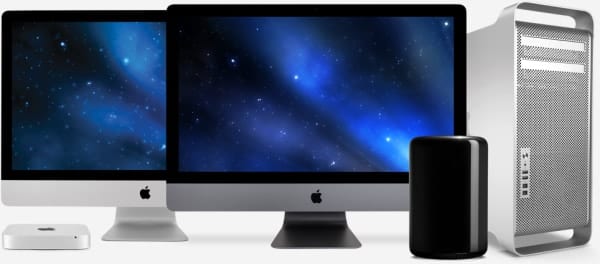
By no means was the Mac created in 2008. Apple’s family of personal computers began all the way back in 1984 with the Macintosh and was re-branded as Mac in 1998. Ten years after that historic re-launch, the Mac lineup had expanded to feature the iMac, Mac Pro, Mac mini, MacBook and MacBook Pro.
Another important addition was made to the Mac lineup in 2008 – the MacBook Air. The MacBook Air featured a sleek new design making it the thinnest notebook in Apple’s lineup. The thin design came with trade-offs in terms of upgradability – a trend that has followed with the other Mac models in subsequent years. But that doesn’t mean you can’t still get more out of your Mac from the past 10 years with DIY upgrades.
In this guide, we show you all the enhancements that can be made to all of the Mac desktop models from the past 10-plus years (as of Oct. 31, 2018) beginning with 2008. Not sure which Mac you have? This article will help you find your Model ID: Finding Your Model Identifier Helps You ID Your Mac, Find Right Upgrades
Don’t forget to check out our Install Video page for step-by-step guides to nearly any upgrade you want to make. And be sure to visit OWC for all your Mac accessories including power adapters, optical drives, and more.
Mac Notebooks: Click here to see how to upgrade any Mac notebook since 2008
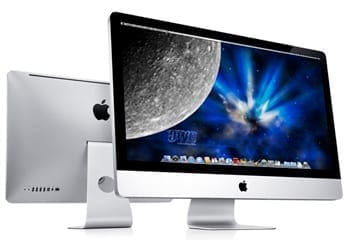
2008: The 2008 iMac featured the sleek aluminum design originally introduced in 2007, coming in 20” and 24” configurations. The aluminum design was a stark contrast with the 2006 and earlier polycarbonate iMac, and it is still echoed in the slim modern iMac models. The ’08 model was mostly a spec bump from the ’07 model, however.
Available upgrades:
- RAM: Up to 6GB
- Internal storage: Up to 12TB
- External storage via USB and FireWire 400/800
2009: Previously available in 20” and 24” models, the late 2009 iMac brought big change in more ways than one. New 21.5” and 27” displays (sizes that are still standard for modern iMacs) were unveiled in an aluminum unibody design. Of course, the internals were also upgraded including all-new video cards and processors and the new maximum RAM capacity was 32GB. There was also an early 2009 model that was a minor refresh that included a FireWire 800 port and an additional USB port.
Available upgrades:
- RAM: Up to 16GB (Early 2009); 16GB (Late 2009, Model 10,1); 32GB (Late 2009, Model 11,1)
- Internal storage: Up to 12TB
- External storage via USB and FireWire 800
2010: The 2010 iMac was essentially a speed bump from the 2009 models, featuring the same design with better specs.
Available upgrades:
- RAM: Up to 16GB (Mid 2010, Model 11,2); 32GB (Mid 2010, Model 11,3)
- Internal storage: Up to 12TB
- External storage via USB and FireWire 800
2011: The Mid 2011 iMac, the last model to feature a built-in optical drive, added quad-core processors as well as a Thunderbolt port. Specs aside, the design was the same as the previous year model. There was also a Late 2011 iMac that was made available only to education customers at a lower price point. This model had less RAM and a smaller capacity hard drive.
Available upgrades:
- RAM: Up to 32GB (Mid 2011 models); Up to 16GB (Late 2011 model)
- Internal storage: Up to 12TB
- External storage via USB, FireWire 800 and Thunderbolt
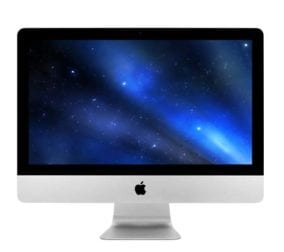 2012: While 2009 brought the iMac design to new heights; the 2012 model trimmed much of the remaining bulk from Apple’s all-in-one desktop. At its thinnest point, the tapered 2012 iMac design was just 5mm. To make this possible, Apple was forced to eliminate the optical drive. Another downside was that DIY upgrades were made more difficult by the model’s new display and glass fusion by lamination. Despite this, RAM and storage upgrades were still possible with the removal of the screen, and fortunately the 27” model featured rear slots to make memory upgrades simple. Another new feature of the 2012 iMac was the optional Fusion drive, which is a hybrid HDD and flash storage system.
2012: While 2009 brought the iMac design to new heights; the 2012 model trimmed much of the remaining bulk from Apple’s all-in-one desktop. At its thinnest point, the tapered 2012 iMac design was just 5mm. To make this possible, Apple was forced to eliminate the optical drive. Another downside was that DIY upgrades were made more difficult by the model’s new display and glass fusion by lamination. Despite this, RAM and storage upgrades were still possible with the removal of the screen, and fortunately the 27” model featured rear slots to make memory upgrades simple. Another new feature of the 2012 iMac was the optional Fusion drive, which is a hybrid HDD and flash storage system.
Available upgrades:
- RAM: Up to 32GB (Model 13,2); Up to 16GB (Model 13,1)
- Internal storage: Up to 8TB (Model 13,2); Up to 4TB (Model 13,1)
- External storage via USB and Thunderbolt 2
2013: After releasing another less powered education-only edition in early 2013, Apple came back with another iMac in late 2013 with faster storage, a more powerful GPU and better Wi-Fi performance. This was the last year the iMac would offer Target Display Mode, with the 2014 and later released Retina models not being compatible with the feature.
Available upgrades:
- RAM: Up to 16GB; Up to 8GB (Model 13,1 and 13,3)
- Internal storage: Up to 4TB
- External storage via USB and Thunderbolt
2014: In 2014, Apple finally brought its Retina display to the iMac lineup starting with the 27” iMac. The Retina display was brought to the 27” iMac without affecting is external enclosure, and the model also received a spec bump with a faster processor and GPU. The storage was Fusion by default for the first time and its ports were updated to Thunderbolt 2. In mid 2014, a refresh was brought to the non-Retina 21.5” iMac.
Available upgrades:
- RAM: Up to 32GB (Note: RAM cannot be upgraded in 21.5” Model 14,4)
- Internal storage: Up to 12TB (3.50 GHz Model 15,1); Up to 8TB (4.00 GHz model 15,1); Up to 4TB(Model 14,4)
- External storage via USB, Thunderbolt and Thunderbolt 2 (Thunderbolt 2 available in Late 2014 models)
 2015: Mid 2015 saw a more affordable 5K iMac released, but late 2015 brought the Retina display to the 21.5” model for the first time. The 21.5” was dubbed the 4K iMac and was launched alongside another edition of the 5K iMac, which featured new processors among other spec updates. Once again, the 27” model featured rear slots for easy memory upgrades whereas the 21.5” did not.
2015: Mid 2015 saw a more affordable 5K iMac released, but late 2015 brought the Retina display to the 21.5” model for the first time. The 21.5” was dubbed the 4K iMac and was launched alongside another edition of the 5K iMac, which featured new processors among other spec updates. Once again, the 27” model featured rear slots for easy memory upgrades whereas the 21.5” did not.
Available upgrades:
- RAM: Up to 64GB (Model 17,1); Up to 32GB (Model 15,1)
- Internal storage: Up to 8TB (Models 15,1 and 17,1); Up to 4TB (Models 16,1 and 16,2)
- External storage via USB and Thunderbolt 2
2017: The 2017 models were the first iMac models to feature Thunderbolt 3 (USB-C) ports. They also received spec bumps from the 2015 editions (2016 did not bring new iMac models). Mid 2017 also brought the new iMac Pro (see below).
Available upgrades:
- RAM: Up to 64GB (Model 18,3); Up to 32GB (Model 18,1 and 18,2)
- Internal storage: Up to 2TB (Model 18,1 and 18,2)
- External storage via USB and Thunderbolt 2
![]()
2017: Featuring the same 27” design with a new Space Gray color, the iMac Pro was announced in mid 2017. The iMac Pro is a workstation-class desktop that possessed the best processors (up to 18 cores), GPUs and SSD storage ever in an iMac. The iMac Pro has Thunderbolt 3 ports as well as a 10Gb Ethernet port for the first time in an iMac. Apple claims it is the fastest Mac ever made.
Available upgrades:
- RAM: Up to 128GB
- External storage and connectivity via Thunderbolt 3, USB 3
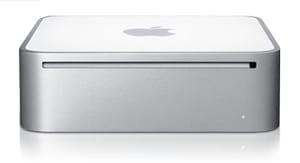 2009: While Apple chose not to release a Mac mini in 2008, it came back in early 2009 with faster data and memory and a Mini DisplayPort. It also was refreshed in late 2009 with a faster processor, more RAM and a larger HDD. The early and late 2009 Mac minis were the first to allow for a second hard drive to be installed in place of the optical drive and featured five USB ports as well as FireWire 800.
2009: While Apple chose not to release a Mac mini in 2008, it came back in early 2009 with faster data and memory and a Mini DisplayPort. It also was refreshed in late 2009 with a faster processor, more RAM and a larger HDD. The early and late 2009 Mac minis were the first to allow for a second hard drive to be installed in place of the optical drive and featured five USB ports as well as FireWire 800.
Available upgrades:
- RAM: Up to 8GB (Early & Late 2009)
- Internal storage: Up to 2TB; 4TB with Data Doubler
- External storage via USB and FireWire 800
2010: The Mac mini finally received an aluminum unibody redesign in mid 2010. The model was more shallow and wider than the previous model and featured a removable panel on the bottom making upgrades easier to perform. A built-in power supply eliminated the need for an external power brick, and the mini-DVI port was replaced with an HDMI port. For the first time, the Mac mini was compatible with 16GB of memory.
Available upgrades:
- RAM: Up to 16GB
- Internal storage: Up to 2TB; 4TB with Data Doubler
- External storage via USB and FireWire 800
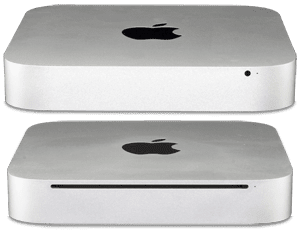 2011: The most significant development of the 2011 Mac mini was the removal of the optical drive. However, a second internal drive can still be added with a Data Doubler kit. The 2011 Mac mini was the first to feature a Thunderbolt port.
2011: The most significant development of the 2011 Mac mini was the removal of the optical drive. However, a second internal drive can still be added with a Data Doubler kit. The 2011 Mac mini was the first to feature a Thunderbolt port.
Available upgrades:
- RAM: Up to 16GB
- Internal storage: Up to 2TB; 4TB with Data Doubler
- External storage via USB, FireWire 800 and Thunderbolt
2012: The 2012 Mac mini is physically identical to the previous model, with spec bumps being the only difference. A second internal drive can still be added with a Data Doubler kit.
Available upgrades:
- RAM: Up to 16GB
- Internal storage: Up to 2TB; 4TB with Data Doubler
- External storage via USB, FireWire 800, Thunderbolt
2014: After skipping 2013, Apple updated the Mac mini in 2014. It again featured the same external appearance; however, users could no longer upgrade the memory. Another big change was the shift to a PCIe SSD. However, the PCIe slot and connecting cable are not present unless the mini is ordered with a Fusion drive or PCIe SSD. For minis with neither, there is no PCIe slot. The 2014 model also features Thunderbolt 2 ports and no longer has FireWire.
Available upgrades:
- Internal storage: Up to 2TB
- External storage via Thunderbolt 2 and USB 3
2018: For the first time in about four years, Apple updated the Mac mini bringing new connectivity with Thunderbolt 3, HDMI 2.0, and available 10Gb Ethernet in a similar design but a new Space Gray color. It also features new processors and faster storage. Apple did bring back upgradable memory, however, with up to 64GB maximum.
Available upgrades:
- RAM: Up to 64GB
- External storage via Thunderbolt 3 and USB 3
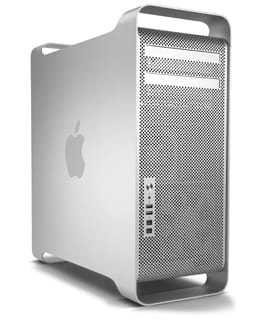 2008: Announced in early 2008, the highly-upgradable silver tower Mac Pro was a speed bump with no major external changes from 2007. The 2008 Mac Pro featured five USB ports, two FireWire 400, and two FireWire 800 ports. Internally, expansion capabilities include two optical bays, four 3.5” hard drive bays, and two PCIe slots.
2008: Announced in early 2008, the highly-upgradable silver tower Mac Pro was a speed bump with no major external changes from 2007. The 2008 Mac Pro featured five USB ports, two FireWire 400, and two FireWire 800 ports. Internally, expansion capabilities include two optical bays, four 3.5” hard drive bays, and two PCIe slots.
Available upgrades:
- RAM: Up to 64GB
- Internal storage: Up to 48TB; add even more storage with Mount Pro
- External storage via USB and FireWire 400/800
- Graphics card
- Processor
- Hard drive controller
2009: Once again, the Mac Pro was largely unchanged in 2009. It featured spec bumps and replaced the FireWire 400 ports with additional FireWire 800 ports. The 2009 model was the first Mac Pro that is compatible with up to 128GB of memory. Internally, expansion capabilities include two optical bays, four 3.5” hard drive bays, and four PCIe slots.
Available upgrades:
- RAM: Up to 128GB (Note: some models limited to 48GB)
- Internal storage: Up to 48TB; add even more storage with Mount Pro
- External storage via USB and FireWire 800
- Graphics card
- Processor
- Hard drive controller
2010: All differences in the 2010 model from the previous year come in the form of spec bumps. Internally, expansion capabilities include two optical bays, four 3.5” hard drive bays, and four PCIe slots.
Available upgrades:
- RAM: Up to 128GB (Note: some models limited to 64GB or 48GB)
- Internal storage: Up to 48TB; add even more storage with Mount Pro
- External storage via USB and FireWire 800
- Graphics card
- Processor
- Hard drive controller
2012: Somewhat controversially, Apple made only incremental upgrades to the 2012 Mac Pro. The physical design was the same and it featured dated processors and no USB 3 or Thunderbolt ports were added. Internally, expansion capabilities include two optical bays, four 3.5” hard drive bays, and four PCIe slots.
Available upgrades:
- RAM: Up to 128GB (Note: some models limited to 48GB)
- Internal storage: Up to 48TB; add even more storage with Mount Pro
- External storage via USB and FireWire 800
- Graphics card
- Processor
- Hard drive controller
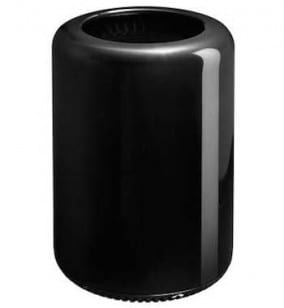 2013: At long last, Apple brought a major redesign to the Mac Pro in late 2013. The exterior design was a polished black aluminum cylinder with a thermal dissipation core with a single fan. The much smaller Mac Pro featured a new array of ports with HDMI, Ethernet, six Thunderbolt 2 and four USB 3 ports. The 2013 model featured up to 12 cores, and user-upgradable memory and internal storage. The processor can also be replaced by users.
2013: At long last, Apple brought a major redesign to the Mac Pro in late 2013. The exterior design was a polished black aluminum cylinder with a thermal dissipation core with a single fan. The much smaller Mac Pro featured a new array of ports with HDMI, Ethernet, six Thunderbolt 2 and four USB 3 ports. The 2013 model featured up to 12 cores, and user-upgradable memory and internal storage. The processor can also be replaced by users.
Available upgrades:
- RAM: Up to 128GB
- Internal storage: Up to 4TB
- External storage via Thunderbolt and USB
- Processor
To see all Mac notebook upgrades since 2008, click here.
Further Reading: Find out more ways that you can get the most out of your Mac with these Rocket Yard articles!
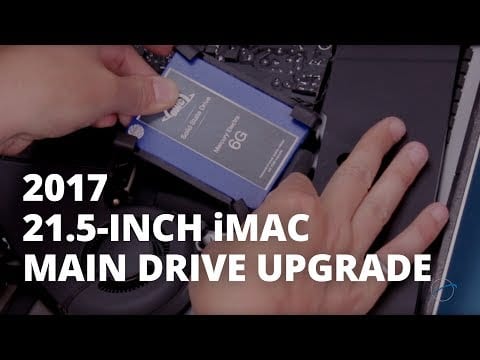







What about upgrading storage on 2017-19 27″ iMac with Fusion drive without causing a split?
You failed to mention in mid-2012 Apple upgraded ALL of its Macs to USB 3.0 — a VERY significant improvement compared to older models.
I wish you all the best in your upgrade tasks, I’ve certainly enjoyed keeping my Mac Pro 3,1 up to date.
Will the Apple OEM / ATI Radeon HD 5870 Graphics Card work in my Early 2008 MacPro 3,1 computer? And will it work faster and better than my nVidia GeForce 8800 GT 512 card?
Also, will the NewerTech MAXPower 4-Port USB 3.1 Gen 1 PCIe Controller Card work in my Early 2008 MacPro 3,1 computer?
I’m running OS X 10.7.5 Lion.
I have a MacPro Early 2008 3,1. I upgraded to an SSD boot drive, 32GB of RAM, additional SSD drives and a CalDigit eSata USB 3.0 PCI card. I originally ordered it with the upgrade nVidia GeForce 8800 GT 512 graphics card. Can I upgrade to the AMD HD 5870 graphics card? If so, will it be faster and work better than my GeForce 8800?
I am running Lion OS 10.7.5. I use the computer for Video Editing using Adobe After Effects and FCP 7. I also do a lot of photo retouching using Adobe Photoshop and Lightroom.
I use OS 10.7.5 Lion because it is the highest I can use and still use my Printer and some special software I use.
I also do a lot of video rendering and photoshop work with plugins. I’m looking for something that will keep up the graphics work that I do until the next MacPro is released in Mid 2019.
Is the AMD HD 5870 a good choice for me?
Thanks.
I don’t know about the 5870, but I ran a flashed 5770 in my Mac Pro 3,1 for a while and it worked well.
I recently upgraded my wife’s iMac7,1 (2007)to High Sierra using dosdude’s High Sierra patch for unsupported Macs. I had to get a Penryn processor (T9300) which was only $40. I added a 2TB SSD drive and maxed out the memory to 6GB and honestly, her 11-year-old iMac runs beautifully and smoothly under High Sierra. Everything works and it runs the latest Adobe Creative Cloud suite flawlessly. The only thing it won’t do is 3D in Adobe but who cares? Oh, you also need to upgrade the wifi/bluetooth card but there’s a great site called OSXwifi that has all the info you need. Everything works great!
An alternative for WiFi that is less expensive is an Edimax USB WiFi dongle. I use one on my non-Airport equipped Mac Pro 3,1 and it works great with Edimax’s OS X drivers. It cost me about $10.
The WiFi dongle is especially nice for machines like iMacs where the Airport card is no longer functional because it restores WiFi without having to open up the machine and replace the card.
I have an old Mac Pro that has been in a closet for several years. It apparently cannot run any OS beyond 10.7.5. (Lion)
I own a MBP (2017) and an iMac (2014). Is there any use I can make of the MacPro – perhaps to install and access the 4 internal drive bays.
Or is it simply a case of outdated machinery with no current place in the modern office.
What model/year is your Mac Pro? My son has a 2009 Mac Pro4,1 which can be flashed to 5,1. These Mac Pros are great machines in that they can be upgraded in so many ways right up to the current OS. Again, it just depends on your model.
Upgrading the GPU in the machine will enable you to use the many hacks available to get all the way to High Sierra. This, of course, is not officially supported by Apple, but they aren’t offering any support for that machine anyway. There are lots of videos on youTube showing how to do this on a Mac Pro 1,1 and up. Good luck.
It sounds like you have a first or second generation Mac Pro. (1,1 or 2,1 model identifier)
It is possible using unsupported methods (more on this online) to get this machine up to newer versions of Mac OS, but you will need a better graphics card than the stock one. Your cheapest bet that is compatible with this machine is probably an 8800 GT. Alternatively, if you want to run a modern OS with security updates and not hack your way to it, I would recommend using Boot Camp to set up Windows on the machine. Windows runs well on these machines, and there are good open source productivity suite options you can use if you want to keep costs down.
This machine’s days of being a powerhouse are probably done, but it can be a good word processing, web browsing, and general office task machine until it’s days are done.
As for the 8800 GT graphics cards, they are all over and usually cheap. If you want the Apple boot screen, you will need to either purchase an Apple card (much more expensive) or flash a PC card with an EFI Rom. (More instructions for this online, definitely the cheaper option)